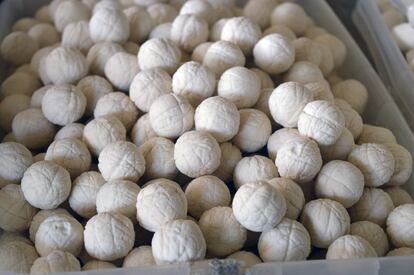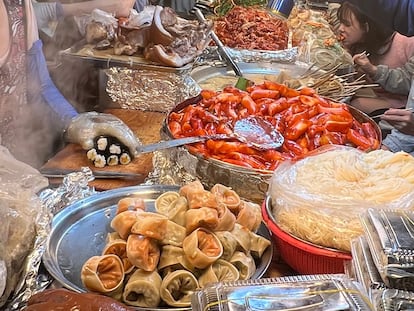‘Qurut’, the dried yogurt balls rich in calcium and protein that have been chewed since the times of Ghengis Khan
Small spheres of fermented milk have figured in the Central Asian diet for centuries and today, can be a delicious option as an appetizer or for adding flavor to salads, soups and stews


They say that, during his voyage aboard the Beagle, Charles Darwin would throw any exotic animal he came across into a cooking pot. Óscar López-Fonseca offers up a tour of the world’s kitchens through culinary experiences that, surely, the father of the theory of evolution would have ventured to taste.
A visit to the markets of any country is always surprising — and always educational. Peculiar-looking fruits and vegetables, cuts of meat unthinkable in other regions or simply, products of whose existence one was previously unaware. Throughout the large part of Asia, through which the mythic Silk Road wound, this latter category includes some usually white balls whose name varies depending on which country they’re in. They’re called qurut or qurt in Kazakhstan, Uzbekistan and Tajikistan; chortan in Armenia; kurut in Kyrgyzstan; aaruul in Mongolia and kashk in Iran. In reality, many of these terms mean the same thing: “dry” or “dried”. That makes for a perfect moniker for the distinctive treat: fermented milk or bitter yogurt, dried in order to prolong its expiration date.
Its uncertain origin point appears to be located in the Asian steppes and dates back many centuries, to when there was neither refrigeration nor the expectation of such things. At the time, it provided an ideal method for the preservation of sheep, goat, camel and horse milk, so that they could form part of nomadic peoples’ provisions when they were on the move. Fermented milk was boiled to convert it to paste to which salt was sometimes added. It was then molded into different shapes and left to dry outdoors in the arid climate of the region. Once finished, it served as food for shepherds during their long trips with livestock in search of pasture, as well as for the members of trade caravans and armies. Historians point out that the troops of infamous Mongolian emperor Genghis Khan carried the food — which, in addition to lacking bulk, was rich in calcium and protein — during their victorious 12th and 13th century military campaigns.
Today, it’s no longer necessary to dehydrate milk or yogurt in order to have dairy products on a trip, but qurut has remained an important part of gastronomic culture in central Asian countries. Aside from being a great appetizer to be enjoyed with a beer, they also dissolve in water to become a drink or ingredient to be added to soups, stews and salads. In Tajikistan, qurut is a fundamental component of qurutob, which is considered a national dish, made of the dairy product plus fresh tomato, fried onion and flaky pastry. It is even said that at the Baikonur Cosmodrome (located in present-day Kazakhstan), qurut was part of the diet of Soviet astronauts. Its consumption is said to promote longevity, improve digestion (I attest to it serving as an antacid), prevent osteoporosis and is highly recommended for infants, young children and pregnant people.
Although qurut traditionally takes the shape of a sphere, it can appear in a variety of forms, starting with its size. It can be as small as a marble and as large as a billiard ball. It is found in conical, square and elongated shapes, or in an undefined blob. Its white color is sometimes replaced by gray, red and even violet tones, depending on its added ingredients. It is usually sold in city markets, where the artisanal manufacturers who sell it in bulk are grouped in a specific section easily identifiable by smell, given that the surrounding air will be inundated with qurut’s sour scent. It can be purchased by the bag, tub or sack, by weight or by unit. The food also shows up in some stores or even roadside gas stations, whose shelves display packages containing vacuum-packed, industrially manufactured qurut.
If its form tends to vary, so too does its flavor. The more recently it has been made, the milder its taste, which some compare to Greek feta cheese. With the passage of time, its flavor intensifies until, in some cases, it can leave a taste in the mouth that resembles that of a blue cheese. In addition, additives that can change it from its traditional white color also give it different taste notes, from smoky to herbal. That is, if it is eaten straight. When added to dishes, it can shift the flavor of the entire plate.
Such notes were recorded as far back as the second half of the 19th century by Ernest Ayscoghe Floyer, a British explorer who traveled in what was then known as Baluchistan (a vast region that included part of the territories of present-day Afghanistan, Iran and Pakistan). He described qurut in his texts as “a hard white cracker of very sour cheese” that, once grated and boiled with herbs, becomes a “very palatable” dish. The culinary versatility of the product is also recorded in a recent cookbook by Iranian food writer and researcher Simi Rezai-Ghassemi entitled Qurut: Cooking with Dried Yoghurt (from the UK editorial Prospect Books). In it, Rezai-Ghassemi delves into the history of the food, devoting the majority of its pages to recipes in which it figures as an ingredient. Genghis Khan would have approved.
Sign up for our weekly newsletter to get more English-language news coverage from EL PAÍS USA Edition
Tu suscripción se está usando en otro dispositivo
¿Quieres añadir otro usuario a tu suscripción?
Si continúas leyendo en este dispositivo, no se podrá leer en el otro.
FlechaTu suscripción se está usando en otro dispositivo y solo puedes acceder a EL PAÍS desde un dispositivo a la vez.
Si quieres compartir tu cuenta, cambia tu suscripción a la modalidad Premium, así podrás añadir otro usuario. Cada uno accederá con su propia cuenta de email, lo que os permitirá personalizar vuestra experiencia en EL PAÍS.
¿Tienes una suscripción de empresa? Accede aquí para contratar más cuentas.
En el caso de no saber quién está usando tu cuenta, te recomendamos cambiar tu contraseña aquí.
Si decides continuar compartiendo tu cuenta, este mensaje se mostrará en tu dispositivo y en el de la otra persona que está usando tu cuenta de forma indefinida, afectando a tu experiencia de lectura. Puedes consultar aquí los términos y condiciones de la suscripción digital.
More information
Archived In
Últimas noticias
Welcome to the post-religion era: The idea of Christianity as the absolute truth has become obsolete
‘I thought you would like it’: The risky sexual practice popularized by TV shows and TikTok
The digitalization of tourism: ‘They promise experiences and gave us the worst possible one’
Mexican peso defies uncertainty with forecasts of a new period of stability in 2026
Most viewed
- Sinaloa Cartel war is taking its toll on Los Chapitos
- Oona Chaplin: ‘I told James Cameron that I was living in a treehouse and starting a permaculture project with a friend’
- Reinhard Genzel, Nobel laureate in physics: ‘One-minute videos will never give you the truth’
- Why the price of coffee has skyrocketed: from Brazilian plantations to specialty coffee houses
- Silver prices are going crazy: This is what’s fueling the rally










































